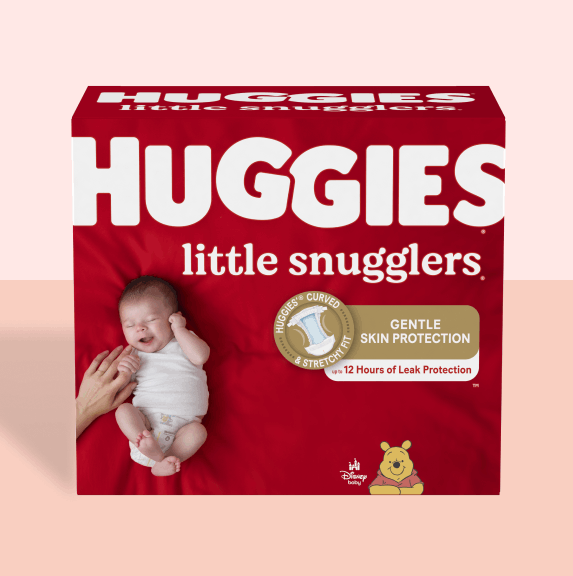Guide for Maintaining Healthy Diapered Skin
- Change & Check: Remove diapers containing poop as soon as possible to help minimize the impact of irritants on baby’s skin. Check the skin for signs of irritation at every diaper change.
- Gently and thoroughly clean the skin with baby wipes at every diaper change: Use properly formulated baby wipes that are designed to effectively remove urine and poop, be gentle on skin to help keep skin clean and healthy, and are pH balanced to match the slightly acidic pH of infant skin.
- Keep baby’s skin dry: Select diapers that have a breathable outer cover and are designed to quickly absorb fluid and lock it away from baby skin, like Huggies® Little Snugglers® diapers. Diapers with wetness indicators can help you know when it's time to change the diaper.
- Gently contact the skin: Maintaining an intact skin barrier is essential for rash prevention. Using products that are made with gentle materials and are specifically designed to minimize friction against the skin can help mitigate the risk of skin barrier damage. It has been demonstrated in research that the use of properly formulated baby wipes that gently glide across the skin while cleaning can be superior to cloth and water for healthy skin, especially for delicate skin.
- Maintain healthy skin pH: Baby’s skin pH is slightly acidic which is very important to maintain skin barrier function, maintain a healthy microbiome, and protect skin from harmful bacteria. An increase in skin pH has been associated with increased susceptibility to diaper rash.
- Use barrier creams: Ointments or barrier creams can help prevent the onset of diaper rash or reduce severity by protecting the skin from damage by exposure to irritants, excess wetness, and friction. Ensure products used are made with ingredients known to be gentle and safe on baby skin.
- Look for other risk factors: Frequent poop or diarrhea, antibiotics use, food allergies, compromised skin, or underlying skin conditions can increase the risk for skin irritation and rash.
Infant skin is delicate and still maturing during the first year of life. Although it is well-documented that the main causes of diaper rash are prolonged contact of skin with irritants present in poop and urine, many other factors can contribute to irritation in the diaper area, and it may not be easy to identify the root cause.
If diaper rash is persistent, lasting more than 3 days and/or symptoms have gotten worse, consult with a medical professional to identify the root cause of irritation and develop a skin care plan that considers the unique needs of baby.
Karien Rodriguez, Ph. D. génie biomédical
Debbie Ngai, BS en génie chimique
approuvé par le Dr Peter Lio, MD, FAAD, dermatologue certifié par le conseil d'administration; professeur adjoint d’enseignement clinique de dermatologie et de pédiatrie à la Northwestern University Feinberg School of Medicine; directeur fondateur du Chicago Integrative Eczema Center.
Apprenez-en davantage sur le Guide sur les soins de l’érythème fessier de Huggies®









